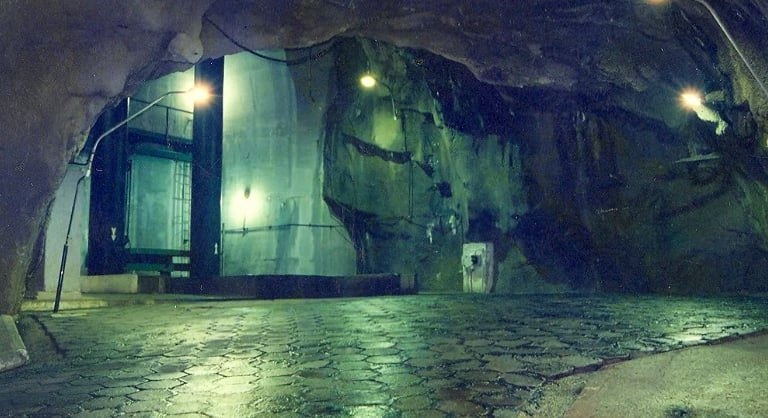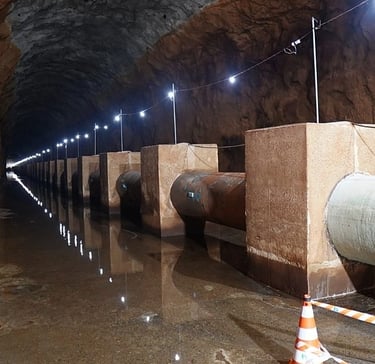Santa Tereza/Voturuá Reservoir: Engineering Thirst Quenching Brazil's Coastline
Santa Tereza/Voturuá Reservoir: Engineering Thirst Quenching Brazil's Coastline and Driving Development. The escalating demand for potable water along Brazil's Baixada Santista coastline, fueled by urban and industrial expansion, urgently required a robust and efficient solution. The Driving Development.
TRAVEL
Everton Faustino
5/1/20254 min read


Inside the mountain - Santa Tereza - Voturuá Water Reservoir.
The monumental Santa Tereza/Voturuá Reservoir emerged as an engineering marvel, transforming the region's water supply landscape.
The discovery of the solution to ensure a continuous water supply resonated with the strategic vision of Sabesp, the state's water utility, which identified the area nestled between the hills of São Vicente and Santos as a geographically strategic point for constructing a large-scale reservoir. The inspiration for the project lay in the long-term necessity for water security, replicating successful models from other regions and adapting them to the local topography and specific characteristics.
The technology employed in the construction of the Santa Tereza/Voturuá Reservoir represented a significant advancement for its time. Rock excavation techniques, large-volume concrete pouring, and high-performance waterproofing were crucial in erecting the imposing structure capable of storing billions of liters of water. The investment value in the project was substantial, reflecting its complexity and magnitude, yet essential to guarantee the quality of life and sustainable development of the region.
The realization of the construction was not without its difficulties. The rugged terrain, the need to divert pre-existing watercourses, and the complex logistics for transporting materials posed significant challenges for the engineering and construction teams. The total cost of the project, while considerable, was justified by the long-term benefits the reservoir would bring to the population. Potential reverses, such as construction delays and environmental impacts during the implementation phase, were mitigated through careful planning and rigorous control measures.
The construction time, which spanned several years, demanded patience and coordination among the various stakeholders involved. However, the wait proved worthwhile. The advantages of the Santa Tereza/Voturuá Reservoir are numerous: increased water storage capacity, guaranteed supply even during drought periods, improved pressure in the distribution network, and greater water security for the population of Baixada Santista.
The result for the population is tangible. Residents and businesses in the region now benefit from a more reliable and stable water supply, boosting economic growth, quality of life, and social well-being. The Santa Tereza/Voturuá Reservoir has solidified its position as a landmark of Brazilian engineering and an example of how well-planned and executed infrastructure can transform the lives of thousands.
In conclusion, the Santa Tereza/Voturuá Reservoir is not merely a structure of concrete and water; it is a symbol of human capacity to overcome challenges and build a safer and more prosperous future for communities. Its story of necessity, innovative solution, and positive impact resonates as a legacy for future generations along Brazil's coast.
The Santa Tereza/Voturuá Reservoir, while crucial for the Baixada Santista, finds parallels in other large-scale water storage projects globally. Unlike some gravity-fed systems reliant on mountainous terrain, its construction in a relatively flatter coastal region highlights innovative engineering solutions for water security. Compared to purely single-purpose reservoirs focused solely on water supply, Santa Tereza/Voturuá primarily addresses domestic and industrial needs, differing from multi-purpose dams that might also incorporate hydroelectric power generation or flood control. Projects like the Thames Water Ring Main in London, focused on distribution rather than raw water storage, represent a different approach to urban water resilience. The scale of Santa Tereza/Voturuá, holding billions of liters, positions it among significant regional water security infrastructures, though it might not reach the capacity of mega-dams found in larger river basins. Its success underscores the importance of localized, strategically placed reservoirs in ensuring water independence for densely populated coastal areas facing unique hydrological challenges.


Keywords: Santa Tereza Reservoir, Voturuá Reservoir, Water supply Baixada Santista, Water solution, Civil engineering, Construction technology, Infrastructure investment, Social impact, Sabesp.
When Can You Visit the Santa Tereza/Voturuá Tunnel Reservoir?
Visits to the Santa Tereza/Voturuá Tunnel Reservoir are available every 2 to 3 years, typically during scheduled cleaning and maintenance periods.
Each guided tour lasts approximately 40 minutes, organized in groups, with time slots available between 9:00 AM and 4:00 PM.
Minimum age requirement is 12 years old, and visits are not recommended for pregnant women, people with claustrophobia, or individuals with limited mobility.
How to Book Your Visit
Advance booking is mandatory through Sabesp, the water utility company.
☎ Phone for reservations: +55 (13) 3201‑2657Spaces are limited, usually capped at around 500 visitors per event, and slots fill up quickly.
Stay tuned to official announcements by Sabesp and the São Paulo State News Network, which announce when registrations are open to the public.
How to Get There
Access via Santos (Santa Terezinha side)
The tunnel has entrances at both ends: Santos (Santa Terezinha Hill) and São Vicente (Voturuá Hill).
From Avenida Dr. Moura Ribeiro, in the Marapé district of Santos, follow signs leading up to Santa Terezinha Hill.
Access via São Vicente / Voturuá Ecological Park
Use this address: Rua Anita Costa, s/n – Vila Voturuá, São Vicente.
Look out for signposts pointing to the Ecological Park and Reservoir Entrance.
Pro Tip
Enhance your experience by pairing the tunnel visit with a ride on the São Vicente Cable Car, which connects Itararé Beach to the top of Voturuá Hill, 180 meters above sea level. From there, you'll enjoy stunning panoramic views of Santos, São Vicente, and the Baixada Santista region.
What to Bring and Wear
PPE (Personal Protective Equipment) is provided by Sabesp, including a helmet, boots, and occasionally a safety vest.
Wear comfortable clothes: long pants, light shirt, and suitable sneakers.
Bring a water bottle, sunscreen, and a light snack.
Prohibited items: pets, wheelchairs, walking canes, and pregnant individuals are not allowed on the tour for safety reasons.
What You’ll See
A massive 1-kilometer tunnel, divided into two chambers, reaching up to 13 meters in height and 15 meters in width—a true feat of engineering carved into solid rock.
Visible water level markings and natural rock formations, offering a glimpse into the history of the excavation and maintenance works.
A fully functional automated valve control system, remotely monitored by Sabesp’s Operations Control Center in Santos.
